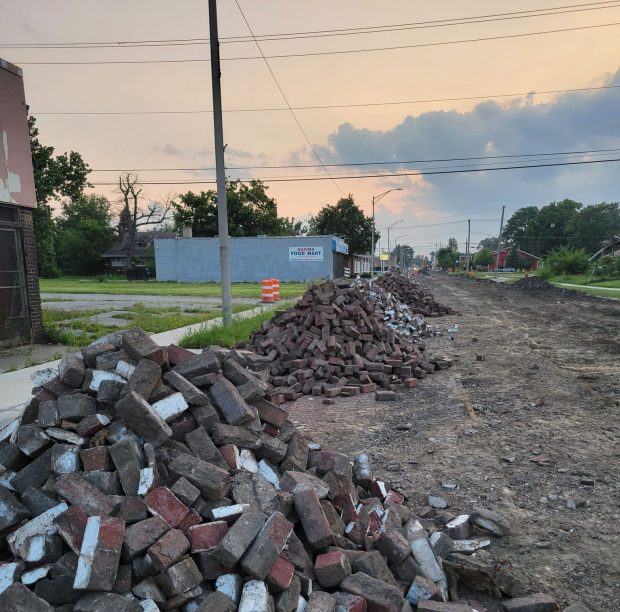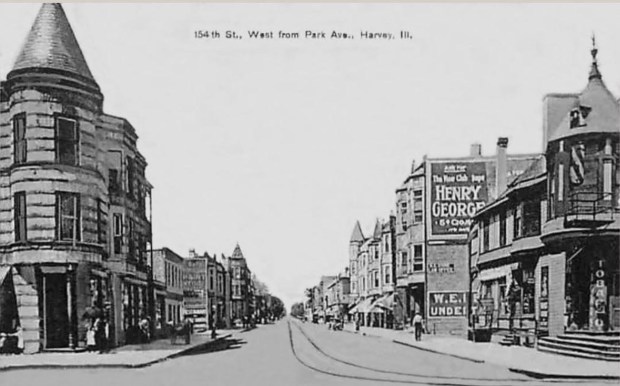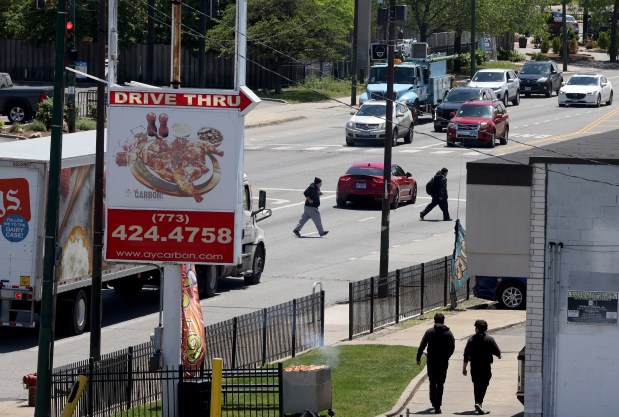The Harvey Historical Society continues to advocate for the preservation of the city’s historic downtown buildings and cobblestone roads, but city leaders are pursuing a different approach.
Under Mayor Christopher Clark’s Building a Better Harvey initiatives, the city has approved several contracts for demolishing deteriorated structures that once served as residential or business premises, as detailed in the requests for proposals and bid packages posted on the city’s website.
Many of the structures are located on 154th Street and Broadway Avenue, areas with a rich history that, according to Ryan Sinwelski, lead preservationist for the historical society, could be restored rather than demolished.
“Even if you don’t care about the beautiful history and these buildings that are priceless … just think of the fact that it’s just wasting Harvey’s public resources,” he said.
The city’s spokesperson who arranges interviews for Clark and other city officials, Glenn Harston, did not respond to an interview request.
In the heart of Harvey’s downtown, 154th Street was once filled with clothing stores and businesses that attracted visitors to the city. In a Facebook group called I’m from Harvey, IL, past and current residents often reminisce and share stories of how the city used to be, when Harvey was referred to as “uptown” and Chicago was considered “downtown,” before the 1990s when businesses moved out and the city’s population embarked on a steady decline.
Sinwelski said he is fighting to preserve part of that history, of the Harvey that used to be.
In March 2023, the city received more than $2 million in federal funding for infrastructure improvements with $750,000 dedicated toward demolishing vacant buildings and $1.5 million toward streetlight improvements.
Sinwelski said most of the historic buildings on 154th Street and Broadway have already been demolished. The city is now focusing on removing the brick roads on 154th Street, he said.

According to a notice on the city’s Facebook, the 154th Street improvement project began July 8 with an anticipated completion date in November. Bids for the project, which involves the complete reconstruction of 154th Street from Wood Street to Broadway Avenue, were accepted until April 19.
Once completed, residents can expect “new curbs, freshly laid gutters, an end to potholes and improved infrastructure,” the notice reads.
For Sinwelski, the decision to demolish blighted buildings in Harvey reflects a frequent pattern among municipal leaders: allowing older buildings to deteriorate until demolition becomes necessary. Instead of designating historic structures as landmarks and investing in their restoration and repurposing, the focus often shifts to demolition, he said.
Sinwelski believes the funds should be allocated to demolishing the numerous burned-out homes scattered throughout Harvey.
“Why are we using precious demolition grants … limited funds for demolishing the select buildings, and not demolishing the half burnt out wooden houses that are scattered?” Sinwelski said.

Recently, the Commission on Chicago Landmarks blocked the demolition of a 2-story building on Michigan Avenue that is part of the historic Motor Row District. Sinwelski said he had hoped to see that same landmark designation in Harvey’s Motor Row District on Broadway.
“I was so happy to see that, you know, that’s the sort of protection we should have in Harvey as well,” he said.
From a financial standpoint, Kendra Parzen, the Chicago area advocacy manager for Landmarks Illinois, argues that investing in historic buildings typically yields long-term financial benefits because historic downtowns tend to attract people, enhancing their economic appeal.
“People are attracted to historic buildings. They like to come to downtowns where they can see historic buildings and feel sort of that atmosphere of what their downtown has looked like over time,” Parzen said. “So in combination with smart investment strategies encouraging economic development, historic buildings can really be an important part of downtown revitalization.”
However, Parzen said most don’t understand the value of investing in historic buildings, choosing to demolish and rebuild new structures instead.
“I think that actually the perception and the idea that it’s not possible or worthwhile is a bigger barrier than actual actually doing the work of preserving and reusing historic building in many cases,” she said.
Sinwelski said he had brought an interested investor, Adrian Miller, to speak at a City Council meeting in October 2023. According to the city’s meeting minutes, Miller said he was interested in investing in a few buildings near the Metra Station to revitalize the area. Sinwelski said Miller met with Clark after the meeting, but no further action was taken.
Some communities have made an effort to preserve and repurpose historic buildings.
For example, south suburban Lockport was recognized for efforts to strengthen its downtown, which has several renovated brick buildings that could have easily been torn down after sitting vacant for years. Blue Island renovated the Lyric Theater on Western Avenue, creating momentum to attract other businesses in an effort to revitalize the downtown area.
“Unfortunately, it’s hard, some people just don’t care,” Sinwelski said. ” And they don’t understand. … A good majority of the time, older materials are actually better quality. They truly are irreplaceable.”
smoilanen@chicagotribune.com




